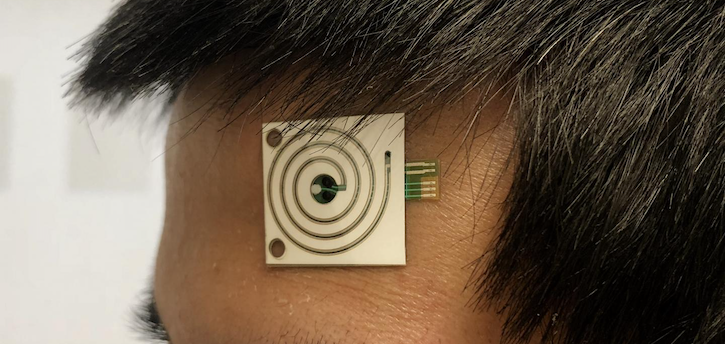Wearable Sensors Monitor Sweat Rate, Electrolytes and Metabolites for Health
Perspiration tests can be used for medical diagnoses and the assessment of athletes.

Photo/Thumb have been modified. Courtesy of Bizen Maskey, Sunchon National University.
Getting blood drawn is not considered a fun activity for many. But for a particular segment of the population, it is a legitimate fear. Trypanophobia, or fear of needles, affects approximately 50 million Americans. So how can these people monitor their health?
One possible answer: wearable skin sensors.
Scientists at the University of California (UC), Berkeley are developing devices that can detect what’s in your sweat. The sensors can monitor sweat rate and the electrolytes and metabolites in sweat — which can reveal a lot about health.
“Using these wearable devices, we can now continuously collect data from different parts of the body, for example to understand how the local sweat loss can estimate whole-body fluid loss,” said Hnin Yin Yin Nyein, a Ph.D. candidate in the materials science and engineering division at the Lawrence Berkeley National Laboratory.
Sweat sensing is a noninvasive and continuous way to monitor various biomarkers for many physiological conditions, experts suggest.
The research team used a roll-to-roll processing technique, which they believe is a promising method for cost-effective fabrication of flexible electronics. Researchers combined roll-to-roll rotary screen printing of sensing electronics with roll-to-roll laser cutting of microfluidic channels. This technique allowed the researchers to develop a wearable patch that could be mass produced at high yield.
“Roll-to-roll processing enables high-volume production of disposable patches at low cost,” said Jussi Hiltunen, VTT Technical Research Center of Finland. “Academic groups gain significant benefit from roll-to-roll technology when the number of test devices is not limiting the research. Additionally, upscaled fabrication demonstrates the potential to apply the sweat-sensing concept in practical applications.”
The patch has two layers. The first has a patterned electrode system for transducing analyte concentrations and monitoring sweat rate. The second is a microfluidic adhesive layer with a sweat collection reservoir and spiral microfluidic channel to guide the sweat flow.
The wearable tracks how fast sweat moves through the microfluidic and the sensors report how much the person is sweating. The microfluidics have chemical sensors that can detect concentrations of electrolytes, including potassium and sodium, and metabolites like glucose.
Researchers put the sensors on different spots on volunteers’ bodies, including the forehead, forearm, underarm and upper back, to measure their sweat rates and sodium and potassium levels in their sweat while riding an exercise bike.
The research team found that local sweat rate could show an individual’s overall liquid loss during exercise. This could be a way for athletes to know if they are pushing themselves too hard, the study authors suggested.
“Traditionally what people have done is they would collect sweat from the body for a certain amount of time and then analyze it,” Nyein said. “So you couldn’t really see the dynamic changes very well with good resolution.”
The researchers also used the sensors to compare sweat glucose and blood glucose levels in healthy and diabetic patients. They found that a single sweat glucose measurement does not necessarily indicate a person’s blood glucose level.
“There’s been a lot of hope that non-invasive sweat tests could replace blood-based measurements for diagnosing and monitoring diabetes, but we’ve shown that there isn’t a simple, universal correlation between sweat and blood glucose levels,” said Mallika Bariya, a Ph.D. student in materials science and engineering at UC Berkeley. “This is important for the community to know, so that going forward we focus on investigating individualized or multi-parameter correlations.”
The researchers will conduct more comprehensive longitudinal studies to extract personalized relations between sweat parameters and medical and physiological status. The studies could determine the uses and limitations of sweat sensing going forward, the authors suggest.
The paper can be found in the journal Science Advances.
Get the best insights in digital health directly to your inbox.
Related
British NHS To Give Out Wearables For Diabetes Prevention
Wearable Device Monitors Fetal Heartbeat, Could Reduce Stillbirths
Wearable Device Could Help Patients Experiencing an Overdose
Children’s hospitals face complex challenges dealing with disasters
April 18th 2025Pediatric hospitals deal with different factors in weather-related events and other emergencies. Terri Wilson of the Children’s Hospital Association talks about the challenges and the need for more planning and support.
Telehealth faces a looming deadline in Washington | Healthy Bottom Line podcast
February 12th 2025Once again, the clock is ticking on waivers for telemedicine and hospital-at-home programs. Kyle Zebley of the American Telemedicine Association talks about the push on Congress and the White House.